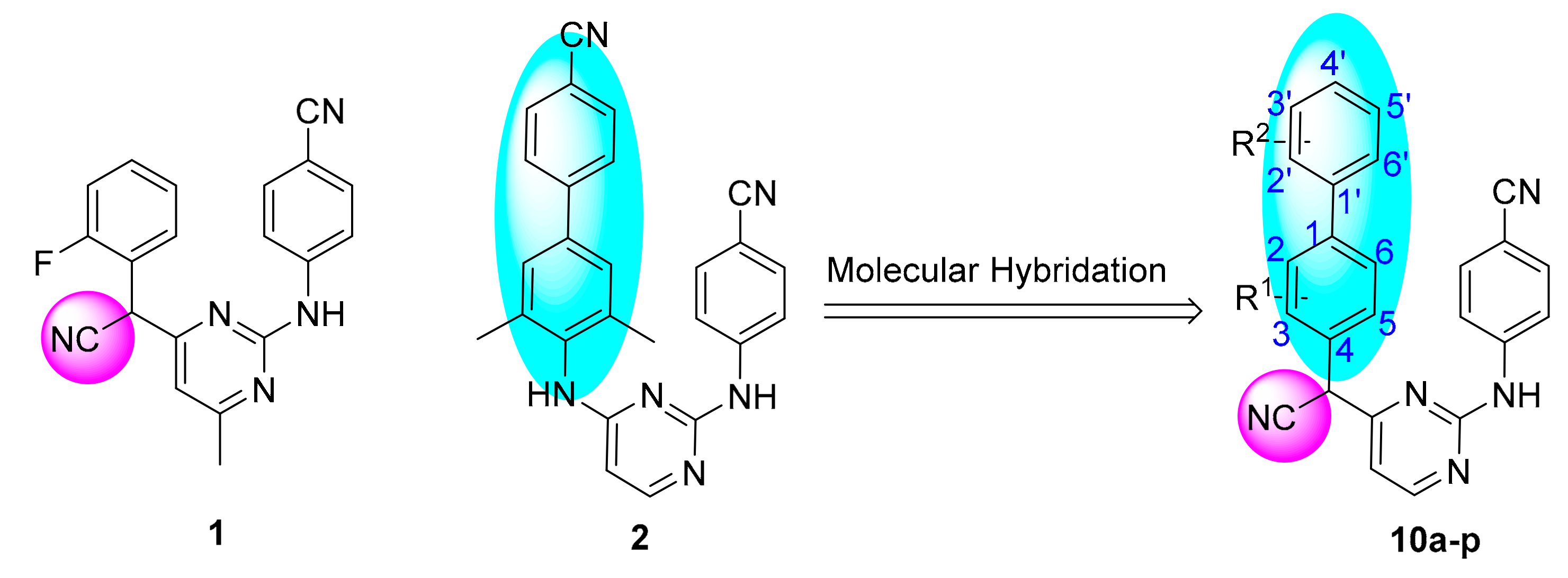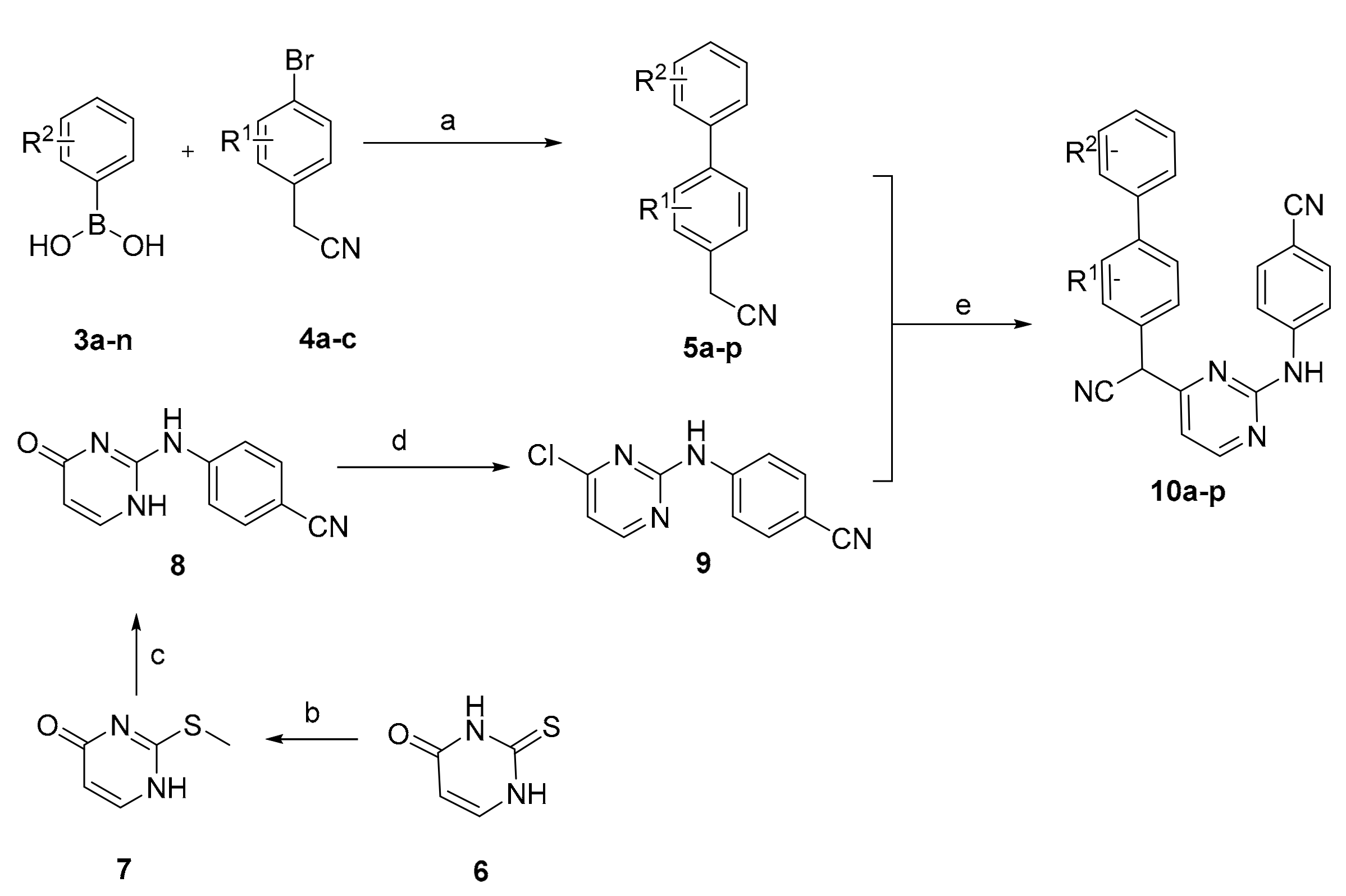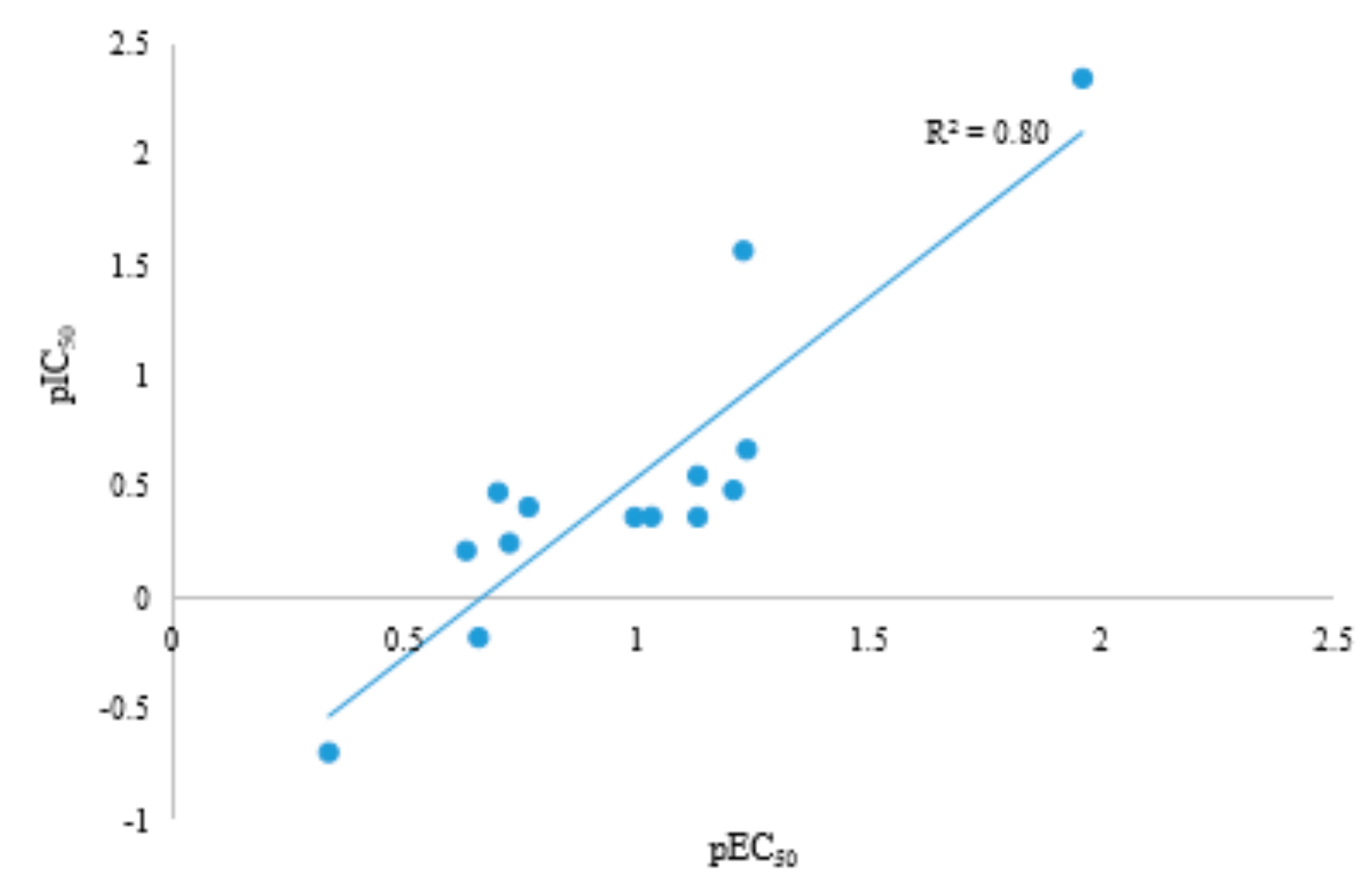Design of Biphenyl-Substituted Diarylpyrimidines with a Cyanomethyl Linker as HIV-1 NNRTIs via a Molecular Hybridization Strategy
Abstract
1. Introduction
2. Results and Discussion
2.1. Chemistry
2.2. Biological Activity
3. Materials and Methods
3.1. Apparatus, Materials, and Analytical Reagents
3.2. Chemistry
3.2.1. General Procedure for Synthesis of Compounds 5a–p
3.2.2. General Procedure for Synthesis of Target Compounds 10a–p
3.3. Biological Assays
3.4. Molecular Docking
4. Conclusions
Supplementary Materials
Author Contributions
Funding
Acknowledgments
Conflicts of Interest
References
- Montagnier, L. A History of HIV Discovery. Science 2002, 298, 1727–1728. [Google Scholar] [CrossRef]
- Gallo, R.C. The Early Years of HIV/AIDS. Science 2002, 298, 1728–1730. [Google Scholar] [CrossRef]
- WHO website. HIV/AIDS fact sheet. Available online: https://www.who.int/hiv/data/en/ (accessed on 26 August 2019).
- FDA website. Antiretroviral drugs used in the treatment of HIV infection. Available online: https://www.fda.gov/ (accessed on 12 April 2018).
- Zhan, P.; Pannecouque, C.; De Clercq, E.; Liu, X. Anti-HIV Drug Discovery and Development: Current Innovations and Future Trends. J. Med. Chem. 2016, 59, 2849–2878. [Google Scholar] [CrossRef]
- Murphy, E.L.; Collier, A.C.; Kalish, L.A.; Assmann, S.F.; Para, M.F.; Flanigan, T.P.; Kumar, P.N.; Mintz, L.; Wallach, F.R.; Nemo, G.J.; et al. Highly Active Antiretroviral Therapy Decreases Mortality and Morbidity in Patients with Advanced HIV Disease. Ann. Intern. Med. 2001, 135, 17–26. [Google Scholar] [CrossRef]
- Deeks, S.G.; Lewin, S.R.; Havlir, D.V. The end of AIDS: HIV infection as a chronic disease. The Lancet 2013, 382, 1525–1533. [Google Scholar] [CrossRef]
- Namasivayam, V.; Vanangamudi, M.; Kramer, V.G.; Kurup, S.; Zhan, P.; Liu, X.; Kongsted, J.; Byrareddy, S.N. The Journey of HIV-1 Non-Nucleoside Reverse Transcriptase Inhibitors (NNRTIs) from Lab to Clinic. J. Med. Chem. 2019, 62, 4851–4883. [Google Scholar] [CrossRef]
- de Béthune, M.-P. Non-nucleoside reverse transcriptase inhibitors (NNRTIs), their discovery, development, and use in the treatment of HIV-1 infection: A review of the last 20 years (1989–2009). Antiviral Res. 2010, 85, 75–90. [Google Scholar] [CrossRef]
- Das, K.; Clark, A.D.; Lewi, P.J.; Heeres, J.; de Jonge, M.R.; Koymans, L.M.H.; Vinkers, H.M.; Daeyaert, F.; Ludovici, D.W.; Kukla, M.J.; et al. Roles of Conformational and Positional Adaptability in Structure-Based Design of TMC125-R165335 (Etravirine) and Related Non-nucleoside Reverse Transcriptase Inhibitors That Are Highly Potent and Effective against Wild-Type and Drug-Resistant HIV-1 Variants. J. Med. Chem. 2004, 47, 2550–2560. [Google Scholar]
- Zuo, X.; Huo, Z.; Kang, D.; Wu, G.; Zhou, Z.; Liu, X.; Zhan, P. Current insights into anti-HIV drug discovery and development: A review of recent patent literature (2014–2017). Expert Opin. Ther. Pat. 2018, 28, 299–316. [Google Scholar] [CrossRef]
- Adams, J.; Patel, N.; Mankaryous, N.; Tadros, M.; Miller, C.D. Nonnucleoside reverse transcriptase inhibitor resistance and the role of the second-generation agents. Ann. Pharmacother. 2010, 44, 157–165. [Google Scholar] [CrossRef]
- Molina, J.M.; Cahn, P.; Grinsztejn, B.; Lazzarin, A.; Mills, A.; Saag, M.; Supparatpinyo, K.; Walmsley, S.; Crauwels, H.; Rimsky, L.T.; et al. Rilpivirine versus efavirenz with tenofovir and emtricitabine in treatment-naive adults infected with HIV-1 (ECHO): A phase 3 randomised double-blind active-controlled trial. The Lancet 2011, 378, 238–246. [Google Scholar] [CrossRef]
- Anta, L.; Llibre, J.M.; Poveda, E.; Blanco, J.L.; Álvarez, M.; Pérez-Elías, M.J.; Aguilera, A.; Caballero, E.; Soriano, V.; De Mendoza, C.; et al. Rilpivirine resistance mutations in HIV patients failing non-nucleoside reverse transcriptase inhibitor-based therapies. AIDS 2013, 27, 81–85. [Google Scholar] [CrossRef]
- Li, D.; Zhan, P.; De Clercq, E.; Liu, X. Strategies for the design of HIV-1 non-nucleoside reverse transcriptase inhibitors: Lessons from the development of seven representative paradigms. J. Med. Chem. 2012, 55, 3595–3613. [Google Scholar] [CrossRef]
- Fleming, F.F.; Yao, L.; Ravikumar, P.C.; Funk, L.; Shook, B.C. Nitrile-containing pharmaceuticals: Efficacious roles of the nitrile pharmacophore. J. Med. Chem. 2010, 53, 7902–7917. [Google Scholar] [CrossRef]
- Wang, Y.; Du, Y.; Huang, N. A survey of the role of nitrile groups in protein-ligand interactions. Future Med. Chem. 2018, 10, 2713–2728. [Google Scholar] [CrossRef]
- Wang, J.; Liu, H. Application of Nitrile in Drug Design. Chin. J. Org. Chem. 2012, 32, 1643–1652. [Google Scholar] [CrossRef]
- Han, S.; Lei, Y.; Pannecouque, C.; De Clercq, E.; Zhuang, C.; Chen, F. Fragment-based discovery of sulfur-containing diarylbenzopyrimidines as novel nonnucleoside reverse transcriptase inhibitors. Chin. Chem. Lett. 2019. [Google Scholar] [CrossRef]
- Han, S.; Sang, Y.; Wu, Y.; Tao, Y.; Pannecouque, C.; De Clercq, E.; Zhuang, C.; Chen, F.E. Molecular Hybridization-Inspired Optimization of Diarylbenzopyrimidines as HIV-1 Nonnucleoside Reverse Transcriptase Inhibitors with Improved Activity against K103N and E138K Mutants and Pharmacokinetic Profiles. ACS Infect. Dis. 2019. [Google Scholar] [CrossRef]
- Zhuang, C.; Pannecouque, C.; De Clercq, E.; Chen, F. Development of non-nucleoside reverse transcriptase inhibitors (NNRTIs): Our past twenty years. Acta Pharm. Sin. B 2019. [Google Scholar] [CrossRef]
- Jin, K.; Sang, Y.; Han, S.; De Clercq, E.; Pannecouque, C.; Meng, G.; Chen, F. Synthesis and biological evaluation of dihydroquinazoline-2-amines as potent non-nucleoside reverse transcriptase inhibitors of wild-type and mutant HIV-1 strains. Eur. J. Med. Chem. 2019, 176, 11–20. [Google Scholar] [CrossRef]
- Zeng, Z.S.; Liang, Y.H.; Feng, X.Q.; Chen, F.E.; Pannecouque, C.; Balzarini, J.; De Clercq, E. Lead optimization of diarylpyrimidines as non-nucleoside inhibitors of HIV-1 reverse transcriptase. ChemMedChem 2010, 5, 837–840. [Google Scholar] [CrossRef]
- Sang, Y.; Han, S.; Pannecouque, C.; De Clercq, E.; Zhuang, C.; Chen, F. Conformational restriction design of thiophene-biphenyl-DAPY HIV-1 non-nucleoside reverse transcriptase inhibitors. Eur. J. Med. Chem. 2019, 182, 111603. [Google Scholar] [CrossRef]
- Sang, Y.; Han, S.; Han, S.; Pannecouque, C.; De Clercq, E.; Zhuang, C.; Chen, F. Follow on-based optimization of the biphenyl-DAPYs as HIV-1 nonnucleoside reverse transcriptase inhibitors against the wild-type and mutant strains. Bioorg. Chem. 2019, 89, 102974. [Google Scholar] [CrossRef]
- Sang, Y.; Han, S.; Pannecouque, C.; De Clercq, E.; Zhuang, C.; Chen, F. Ligand-Based Design of Nondimethylphenyl-Diarylpyrimidines with Improved Metabolic Stability, Safety, and Oral Pharmacokinetic Profiles. J. Med. Chem. 2019, 62, 11430–11436. [Google Scholar] [CrossRef]
- Jin, K.; Yin, H.; De Clercq, E.; Pannecouque, C.; Meng, G.; Chen, F. Discovery of biphenyl-substituted diarylpyrimidines as non-nucleoside reverse transcriptase inhibitors with high potency against wild-type and mutant HIV-1. Eur. J. Med. Chem. 2018, 145, 726–734. [Google Scholar] [CrossRef]
- Jin, K.; Liu, M.; Zhuang, C.; De Clercq, E.; Pannecouque, C.; Meng, G.; Chen, F. Improving the positional adaptability: Structure-based design of biphenyl-substituted diaryltriazines as novel non-nucleoside HIV-1 reverse transcriptase inhibitors. Acta Pharm. Sin. B 2020, 10, 344–357. [Google Scholar] [CrossRef]
- George, G.J.E.; Patrice, P.; Rene, D.J.M.; Henricus, K.L.M.; Maarten, V.H.; Desire, D.F.F.; Jan, H.; Alfons, V.A.K.J.; Joanns, L.P.; Jan, J.P.A. HIV inhibiting pyrimidines derivatives. WO03016306 (A1), 2003, Assignee: Janssen Pharmaceutica N.V., Belgium.
- Du, Z.; Zhou, W.; Wang, F.; Wang, J.-X. In situ generation of palladium nanoparticles: Ligand-free palladium catalyzed ultrafast Suzuki–Miyaura cross-coupling reaction in aqueous phase at room temperature. Tetrahedron 2011, 67, 4914–4918. [Google Scholar] [CrossRef]
- Feng, X.-Q.; Liang, Y.-H.; Zeng, Z.-S.; Chen, F.-E.; Balzarini, J.; Pannecouque, C.; De Clercq, E. Structural Modifications of DAPY Analogues with Potent Anti-HIV-1 Activity. ChemMedChem 2009, 4, 219–224. [Google Scholar] [CrossRef]
- Liang, Y.H.; He, Q.Q.; Zeng, Z.S.; Liu, Z.Q.; Feng, X.Q.; Chen, F.E.; Balzarini, J.; Pannecouque, C.; Clercq, E.D. Synthesis and anti-HIV activity of 2-naphthyl substituted DAPY analogues as non-nucleoside reverse transcriptase inhibitors. Bioorg. Med. Chem. 2010, 18, 4601–4605. [Google Scholar] [CrossRef]
- Franciszek, H.; Malgorzata, K.; Marek, K.; Joanna, H.; Jerzy, K.; Jadwiga, T.O. Synthesis of a New Scaffold: The 7H,8H-Pyrimido[1,6-b]pyridazin-6,8-dione Nucleus. Molecules 2007, 12, 2643–2657. [Google Scholar]
- Herold, F.; Kleps, J.; SzczȩSna, B.; Anulewicz-Ostrowska, R. Synthesis and molecular structure of novel 4-aryloctahydropyrido-[1,2-c]pyrimidine derivatives. Cheminform 2002, 39, 773–782. [Google Scholar] [CrossRef]
Sample Availability: Samples of the compounds are available from the authors. |





| Compounds | R1 | R2 | EC50 (µM) b | CC50 (µM) c | SI (ⅢB) d |
|---|---|---|---|---|---|
| HIV-1 ⅢB | |||||
| 10a | H | H | 2.90 ± 1.89 | 30.84 ± 8.57 | 11 |
| 10b | 2-F | H | 4.96 ± 0.56 | 27.34 ± 5.85 | 6 |
| 10c | 3-F | H | 0.33 ± 0.07 | 23.80 ± 4.48 | 73 |
| 10d | 3-F | 2′-Me | 0.43 ± 0.21 | 30.12 ± 1.94 | 70 |
| 10e | 3-F | 3′-Me | 0.43 ± 0.07 | 26.91 ± 3.78 | 63 |
| 10f | 3-F | 4′-Me | 0.43 ± 0.09 | 30.85 ± 2.76 | 72 |
| 10g | 3-F | 2′-OMe | 0.61 ± 0.16 | 30.05 ± 2.31 | 49 |
| 10h | 3-F | 3′-OMe | 1.50 ± 0.24 | 30.65 ± 2.09 | 20 |
| 10i | 3-F | 4′-OMe | 0.51 ± 0.42 | 183.08 ± 52.24 | 361 |
| 10j | 3-F | 2′-F | 0.21 ± 0.05 | 27.86 ± 3.56 | 131 |
| 10k | 3-F | 3′-F | 0.56 ± 0.19 | 30.68 ± 1.79 | 55 |
| 10l | 3-F | 4′-F | 0.18 ± 0.16 | 25.61 ± 3.58 | 139 |
| 10m | 3-F | 2′-Cl | 0.28 ± 0.04 | 22.52 ± 4.70 | 81 |
| 10n | 3-F | 3′-Cl | 0.39 ± 0.10 | 27.56 ± 4.05 | 71 |
| 10o | 3-F | 4′-Cl | 0.18 ± 0.14 | 27.54 ± 7.30 | 153 |
| 10p | 3-F | 4′-CN | 0.027 ± 0.015 | 36.41 ± 10.57 | 1361 |
| 3TC | 7.88 ± 3.15 | >87.24 | >11 | ||
| NVP | 0.20 ± 0.10 | >15.02 | >76 | ||
| ETR | 0.0045 ± 0.001 | >4.60 | >1012 | ||
| RPV | 0.0016 ± 0.0003 | 5.89 ± 0.31 | 3747 |
| Compounds | R1 | R2 | EC50 (µM) | IC50 (µM) a | ||||||
|---|---|---|---|---|---|---|---|---|---|---|
| L100I | E138K | Y181C | K103N | Y188L | F227L + V106A | K103N + Y181C | ||||
| 10a | H | H | >30.84 | ≥12.62 | >30.84 | >30.84 | >30.84 | >30.84 | >30.84 | ND b |
| 10b | 2-F | H | ≥27.33 | 9.29 ± 1.37 | >27.33 | >27.33 | >27.33 | >27.33 | >27.33 | 0.460 ± 0.162 |
| 10c | 3-F | H | ≥10.26 | 1.69 ± 0.17 | 6.37 ± 0.78 | 10.32 ± 0.85 | >23.80 | >23.8 | >23.8 | 0.062 ± 0.024 |
| 10d | 3-F | 2′-Me | 3.67 ± 0.54 | 2.5 ± 0.33 | 4.89 ± 1.07 | 8.14 ± 1.82 | >30.11 | >30.11 | >30.11 | 0.074 ± 0.024 |
| 10e | 3-F | 3′-Me | 9.14 ± 3.61 | 3.59 ± 1.03 | >26.92 | >26.92 | >26.92 | >26.92 | >26.92 | 0.101 ± 0.059 |
| 10f | 3-F | 4′-Me | 6.12 ± 1.62 | 2.55 ± 0.17 | 9.27 ± 1.14 | 8.08 ± 2.74 | >30.85 | >30.85 | >30.85 | 0.093 ± 0.051 |
| 10g | 3-F | 2′-OMe | 4.27 ± 0.46 | 3.66 ± 0.19 | 7.79 ± 1.67 | 9.78 ± 1.60 | >30.04 | >30.04 | >30.04 | 0.233 ± 0.125 |
| 10h | 3-F | 3′-OMe | 8.57 ± 1.26 | 6.16 ± 1.47 | >30.66 | >30.66 | >30.66 | >30.66 | >30.66 | 0.219 ± 0.171 |
| 10i | 3-F | 4′-OMe | 31.56 ± 7.35 | 5.51 ± 1.06 | 8.57 ± 1.21 | 26.97 ± 3.00 | 50.10 ± 6.52 | 52.45 | >183.07 | ND |
| 10j | 3-F | 2′-F | 6.06 ± 2.46 | 1.03 ± 0.17 | 3.4 ± 0.48 | 3.93 ± 0.65 | >27.87 | >27.87 | >27.87 | 0.058 ± 0.032 |
| 10k | 3-F | 3′-F | 9.29 ± 0.57 | 3.36 ± 0.4 | 9.15 ± 0.87 | >30.68 | >30.68 | >30.68 | >30.68 | 0.188 ± 0.172 |
| 10l | 3-F | 4′-F | 6.90 ± 1.76 | 0.98 ± 0.13 | 5.1 ± 0.51 | 6.87 ± 1.17 | >25.60 | >25.6 | >25.6 | ND |
| 10m | 3-F | 2′-Cl | 5.61 ± 1.51 | 2.43 ± 0.5 | 4.53 ± 1.47 | 5.34 ± 0.93 | >22.53 | >22.53 | >22.53 | 0.074 ± 0.024 |
| 10n | 3-F | 3′-Cl | 8.31 ± 1.20 | 2.67 ± 0.21 | 9.19 ± 2.05 | 7.2 ± 0.89 | >27.55 | >11.21 | >27.55 | 0.171 ± 0.132 |
| 10o | 3-F | 4′-Cl | 5.28 ± 1.29 | 1.50 ± 0.28 | 7.49 ± 1.64 | 7.32 ± 0.87 | >27.53 | >27.53 | >27.53 | ND |
| 10p | 3-F | 4′-CN | 1.21 ± 0.21 | 0.17 ± 0.03 | 0.87 ± 0.23 | 0.9 ± 0.27 | 9.81 ± 1.30 | >25.6 | >36.4 | 0.059 ± 0.034 |
| 3TC | 1.96 ± 0.29 | 5.06 ± 0.90 | 4.74 ± 1.31 | 3.98 ± 0.76 | 3.42 ± 0.95 | 2.69 ± 0.87 | 5.50 ± 1.31 | ND | ||
| NVP | 0.98 ± 0.39 | 0.20 ± 0.15 | 6.07 ± 1.55 | 4.70 ± 0.63 | ≥4.62 | ≥4.281 | >15.02 | 0.332 ± 0.11 | ||
| ETR | 0.008 ± 0.002 | 0.008 ± 0.004 | 0.017 ± 0.003 | 0.003 ± 0.001 | 0.017 ± 0.006 | 0.014 ± 0.005 | 0.04 ± 0.01 | 0.009 ± 0.003 | ||
| RPV | 0.002 ± 0.001 | 0.003 ± 0.001 | 0.003 ± 0.001 | 0.001 ± 0.0002 | 0.03 ± 0.009 | 0.044 ± 0.012 | 0.009 ± 0.002 | ND | ||
© 2020 by the authors. Licensee MDPI, Basel, Switzerland. This article is an open access article distributed under the terms and conditions of the Creative Commons Attribution (CC BY) license (http://creativecommons.org/licenses/by/4.0/).
Share and Cite
Lei, Y.; Han, S.; Yang, Y.; Pannecouque, C.; De Clercq, E.; Zhuang, C.; Chen, F.-E. Design of Biphenyl-Substituted Diarylpyrimidines with a Cyanomethyl Linker as HIV-1 NNRTIs via a Molecular Hybridization Strategy. Molecules 2020, 25, 1050. https://doi.org/10.3390/molecules25051050
Lei Y, Han S, Yang Y, Pannecouque C, De Clercq E, Zhuang C, Chen F-E. Design of Biphenyl-Substituted Diarylpyrimidines with a Cyanomethyl Linker as HIV-1 NNRTIs via a Molecular Hybridization Strategy. Molecules. 2020; 25(5):1050. https://doi.org/10.3390/molecules25051050
Chicago/Turabian StyleLei, Yuan, Sheng Han, Yang Yang, Christophe Pannecouque, Erik De Clercq, Chunlin Zhuang, and Fen-Er Chen. 2020. "Design of Biphenyl-Substituted Diarylpyrimidines with a Cyanomethyl Linker as HIV-1 NNRTIs via a Molecular Hybridization Strategy" Molecules 25, no. 5: 1050. https://doi.org/10.3390/molecules25051050
APA StyleLei, Y., Han, S., Yang, Y., Pannecouque, C., De Clercq, E., Zhuang, C., & Chen, F.-E. (2020). Design of Biphenyl-Substituted Diarylpyrimidines with a Cyanomethyl Linker as HIV-1 NNRTIs via a Molecular Hybridization Strategy. Molecules, 25(5), 1050. https://doi.org/10.3390/molecules25051050






